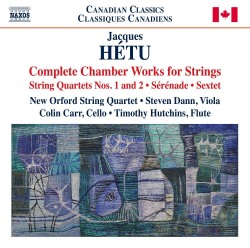
|
Jacques HÉTU (1938-2010)
String Quartet No.1 Op.19 (1972) [18:18]
String Quartet No.2 Op.50 (1991) [18:16]
Scherzo Op.54 (1992) [6:13]
Adagio and Rondo Op.3 No.1a (1960) [9:09]
Sérénade Op.45 (1988) [10:23]a
Sextet Op.71 (2004) [12:07]b
New Orford String Quartet; Timothy Hutchins (flute)a; Steven Dann (viola)b; Colin Carr (cello)b
rec. Multimedia Music Room, Schulich School of Music, McGill University, Montreal, 6-9 May 2012
NAXOS 8.573395 [74:25]
I have long been an admirer of Jacques Hétu's music. I came to know and appreciate it by browsing in some of my second-hand haunts in Brussels. Later I was able to explore his output somewhat more extensively through a three-CD set entirely devoted to his output published as part of the Canadian Music Anthology which may now be hell to obtain. This included quite a number of recordings of many works written up to 1985 albeit with a number of gaps to fill. That CMA box allowed me to widen the picture and led to a fuller appreciation of his output at that time. In the meantime some of his works have appeared in the odd disc with little else to add to my knowledge of his music. With this in the background I was really delighted to see this generously filled release of his complete chamber works for strings - works that bridge some forty years of his composing life.
The earliest piece here may be one of the best known and possibly one of his most popular. The Adagio and Rondo Op.3 No.1a was composed upon his graduation from the Montreal Conservatory but is far from an apprentice work. The music already displays a number of features that one will later regard as fingerprints, one of the most remarkable appearing at the very beginning of the Rondo which opens with a declamatory unison in all four strings. This typical gesture will later re-appear in both string quartets. This early, though by no means negligible work also exists in a version for string orchestra recorded by I Musici de Montréal conducted by Yuli Turovsky: SMCD5131 “Canadian Music for Strings” - may still be available and well worth looking for.
The String Quartet No.1 Op.19 completed in 1972 is a much more developed and mature work that displays the composer's formal mastery and instrumental flair when writing for strings. Incidentally Hétu's first symphony was his Symphony for Strings Op.2 composed in 1959. The first string quartet is laid out in four movements with some emphasis on the Andante, a beautiful elegy building up to a climax before winding down to its conclusion. There follows a lively Scherzo with some slower episodes — another characteristic of many scherzos in Hétu's output. The final movement opens with a unison that mirrors the one that opened the first movement. A fugal episode followed by a short reminiscence of the main theme from the second movement eventually leads into the energetic conclusion. The String Quartet No.2 Op.50 is clearly the work of a composer in full command of his aims and means. As in its predecessor nothing is wasted and the musical discourse unfolds with concision and confidence, everything being tightly knit while remaining strongly expressive. The second string quartet is in three movements: a slow Adagio that remains fragile and tender for the most part but whose mood is briefly shattered by the cello's tense eloquence before regaining the mood of the opening. The second movement is a dance-like Scherzo whereas the concluding Andante, written in memory of the composer's mother who died just prior to the quartet being written, is a beautiful, deeply moving elegy.
The short Scherzo Op.54 written at about the same time as the second string quartet is yet another example of what I am tempted to describe as a typical Hétu Scherzo with lively rhythms, dance-like episodes as well as some slower ones whereas the whole is not without its ferocious, albeit short-lived outbursts. This short work is a telling example of Hétu's mastery in writing for strings.
The short Sérénade Op.45 for flute and string quartet originates from a private commission. Hétu here wrote a lovely work full of nocturnal poetry being a commentary on Act V Scene I of Shakespeare's Merchant of Venice. The final movement is a lively dance capped by a shortened restatement of material from the opening Prelude.
Hétu's String Sextet Op.71 of 2004 is his final chamber work for strings and quite a fine one. The piece is laid-out as an Introduction, theme and variations which allows for a good deal of variety while holding the whole together through the theme or parts of it. The individual variations are strongly contrasted thus allowing the composer to display his obvious enjoyment in writing for them.
This is a splendid release on all counts. The New Orford String Quartet and their colleagues strongly commit themselves to these often quite beautiful works. Their neatly prepared readings are all caught in excellent sound. I must also mention the quartet's viola player Eric Nowlin's well-documented insert notes.
Hubert Culot
 |
 |
|
